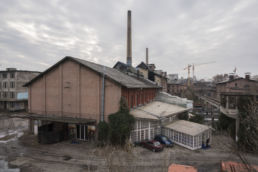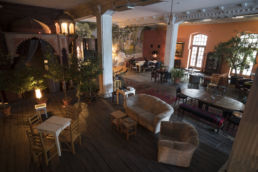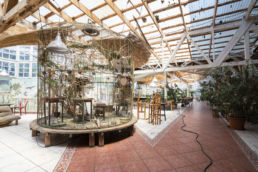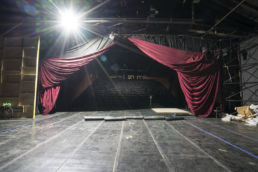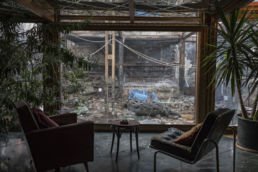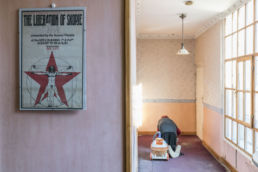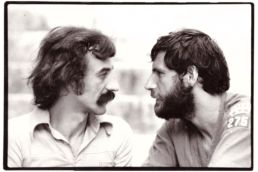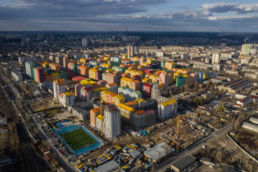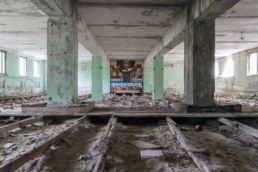This is an excerpt from Meet the man who built Belgrade’s theatre of broken dreams, where the Yugoslav ideal lived and died which was published on The Calvert Journal in June 2019.
Ljubiša Ristić was once the daring star of Yugoslav theatre. Then the state he had dedicated his life and art to collapsed into bloodshed. This is the story of how loyalty to a political ideal ruined a cultural icon.
Among the dilapidated structures of an old industrial district in Belgrade is a crumbling, 19th-century factory. The building, once Yugoslavia’s largest sugar refinery, stands proudly even as parts of its roof succumb to gravity and its red-brick walls gently bow in sympathy. One section of the building, however, remains intact: windows glazed, roof sealed, brickwork perpendicular. In winter, a small steel chimney emits a thin trail of smoke.
In fact, this 50-metre stretch of The Sugar Factory houses a 450-seat avant-garde theatre, as well as a ballet hall, restaurant, bar, greenhouse, and a giant birdcage full of brightly-coloured parakeets. Its palatial spaces and cosy corners blend elements of an ancient temple with a Bond villain’s lair: faux-Roman columns stand by glittering Egyptian arches; murals depict characters from Eastern mythology meeting those from European classics; a grand piano rests on a marble floor under a ceiling of shimmering LED stars, next to a wall of tube televisions.
This is the eponymous home of KPGT, a theatre troupe led by enigmatic director Ljubiša Ristić. Now 72, he is energetic, articulate, and full of charisma. His presence fills the room with an air of unpretentious knowing: a man who has seen it all, remembered every detail, and continued unfazed. In the days when Belgrade was the capital of Yugoslavia, Ristić and KPGT were an international sensation. Today, the director is a controversial character in Serbia and the theatre lies mostly quiet, the restaurant’s ovens cold, the stage empty.
Ristić’s story is one of a cultural icon caught up in a destructive battle for power. His biography maps the rise and collapse of Yugoslavia itself, with all the idealism, compromise, and brutality that ultimately entailed. And, after two decades struggling to survive, there are signs that the story of this man and his theatre might not be over just yet.
Yugoslavia was birthed in the Partisan struggle against Nazi occupation, led by Josip Broz Tito. After the war, Tito united six nation states (Croatia, Slovenia, Serbia, Montenegro, Bosnia and Herzegovina, and Macedonia), along with two autonomous regions (Vojvodina and Kosovo), into a centralised communist republic, promoting “Brotherhood and Unity” while forcefully suppressing nationalist sentiment.
Ristić’s biography maps the rise and collapse of Yugoslavia itself, with all the idealism, compromise, and brutality that ultimately entailed
As the post-war state developed into a global force, prospering in a neutral position between the Cold War superpowers, Ristić, the son of prominent wartime partisans, was growing up in Pristina, Kosovo. Taking after his parents, Ristić was politically minded and a staunch supporter of the federalism of the communist state. He joined the ruling party, the League of Communists, in 1962, aged 16. Six years later, he played a significant role in the 1968 student protest movement, opposing Titoist reforms that he felt betrayed the country’s roots. He left the party in 1971, unable to accept its continued move toward the political centre, which had seen significant powers devolved to Yugoslavia’s individual states, something Ristić feared would lead to a rise in nationalism. Away from politics, Ristić completed his degree at the Belgrade Academy of Theatre, and by the mid-70s was a rising star of stage direction.
When nationalist movements indeed began to take hold across the federation, the director saw an opportunity to promote unity through culture. In 1977, he formed a theatre troupe with Croatian choreographer Nada Kokotović, Slovenian playwright Dušan Jovanović, and Croatian (now Hollywood) actor Rade Šerbedžija. Ristić says that the idea was to collect “the diversity [of Yugoslavia] in a unified cultural space, to preserve these differences which were the richness of society.” They called the troupe “KPGT” — the first letters of the words for “theatre” in four Yugoslav languages.
By the early 1980s, KPGT was a critically acclaimed company operating on the global stage. Their largest production, Carmina Burana, was seen by over 100,000 people in its first fortnight at the Belgrade Sava Centre. Meanwhile, The Liberation of Skopje — one of KPGT’s most renowned productions — would ultimately be performed over 800 times in cities throughout the world, including New York, London, and Moscow.
Contrary to other Yugoslav troupes, KPGT operated without state subsidies, both to maintain freedom of expression and because, for Ristić, ticket sales were the only valuable measure of success: while subsidies kept tickets affordable, they also reduced the appetite for creative risk. Reviewing the US premiere of The Liberation of Skopje in Denver in 1982, the American magazine Bravo positively described KPGT as an “aberration” from the routine and conventional Yugoslav productions emerging at the time.
In 1985, Ristić found KPGT a permanent home in the struggling national theatre in the city of Subotica, Vojvodina. Ristić discovered a staff comprised of bickering nationalities — a microcosm of the growing disagreements between the Yugoslav states — and began forging a unified company able to produce the kind of spectacles that soon placed the city on the cultural map. Danka Palian, a company member from Sarajevo, recalls that Ristić “impressed upon the team his belief that ‘there is one universal language, and it’s the language of theatre’.”
By the end of the 80s, Ristić was one of Yugoslavia’s most important directors, known for a pointed and experimental style that confronted the issues of the day. Festivals organised by KPGT regularly included hundreds of performers from around Yugoslavia and beyond, operating on stages located in multiple cities simultaneously.
“I was given names like ‘the father of political theatre’,” recalls Ristić. “That wasn’t true. We were not using theatre for political activism. We used political themes to tell the stories of life.”

Outside of the theatre, nationalist sentiments were escalating into sporadic violence. Tito’s death in 1980 had fractured the national psyche, and foreign powers, keen to see Yugoslavia’s influence reduced, took the opportunity to stoke division.
In 1986, Slobodan Milošević became leader of the Serbian League of Communists. In order to gain support among Serbian nationalists, he had exploited opposition to Kosovar independence. Once elected, he took control of both Kosovo and Vojvodina by revoking devolved powers, and helped his allies into power in Montenegro. This imbalance of power provided fuel for nationalist movements across the union and, in 1991, Slovenia and Croatia declared independence, triggering war. Over the next four years, the dream of a united Yugoslavia disintegrated in horrifying, bloody fashion.
While Ristić stood opposed to the violence and avoided attachment to any side, the war immediately affected KPGT. Some of the troupe, including its co-founders residing outside Serbia, became detached, and cultural sanctions imposed by the UN made it impossible to tour outside the country, decimating their budget. “We could make $1 million a year in America or Europe,” Ristić says. “Under cultural sanctions, we had no possibility to go abroad.” Unable to travel, KPGT extended their operations to Belgrade in 1994. They squatted the derelict Sugar Factory and began performing to small audiences without windows, doors, power, or water.
When the violence came to a temporary end in 1995, Milošević had recast himself as peacemaker and began promoting “unity” among what remained of the federation. Milošević‘s influential wife and confidante, Mira Marković, decided to counter growing Serbian nationalist forces — which included her husband’s Socialist Party of Serbia (SPS) — with a more traditional form of Yugoslav communism. She formed a new party, The Yugoslav Left (JUL), merging 19 smaller left-wing parties, and began searching for a charismatic leader to unite its various factions.

